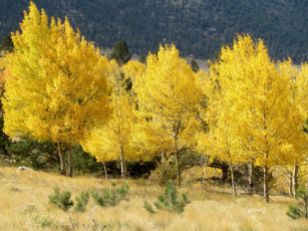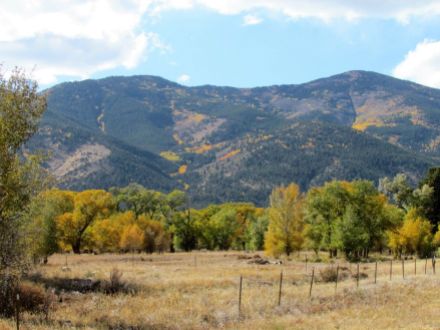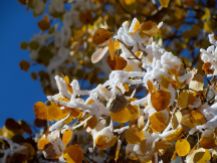Whereas Colorado might not paint much in autumnal reds and clarets, it is a masterful artist when it comes to applying golden brush strokes. Several trees belonging to the willow family grow exceedingly well in our Rocky Mountain state. Plains and Narrow-Leaf Cottonwoods thrive at slightly lower elevations and are no less gorgeous or colorful than their cousins of higher realms—aspen trees—but the latter tend to get most of the glory. And glorious they are, regardless of whether a gauzy green graces their limbs in springtime, or a palette of warmer hues during the fall, as if they were reflecting the different shades of sunshine: much yellow, some orange, little red.
Annually this autumnal pageant is celebrated by Coloradans and out-of-state visitors alike, as though it were nature’s premiere, as well as only performance. Forecasters, based on daylight hours, temperature, and moisture, try to predict the climax of the color change, tourists book hotels weeks, if not months, in advance, aspen lovers make pilgrimages to our montane and subalpine zones to coincide with the most golden glow and brilliant blaze, which usually happens between late September and the middle of October. I am not ashamed to admit that I am one of them, and I am happy to share some of the splendor my eyes have seen.
While you view these photos, visualize the leaves dancing in the wind. The tree’s full name is Quaking Aspen (Populus tremuloides). The tremors or trembling are a result of flattened petioles that attach at right angles to the leaves, which makes them quake and quiver in the slightest breeze. What wonderful performers are these aspens—concurrently with graceful pirouettes, their foliage creates music equally as pleasing to the ears. It should come as no surprise that I consider aspen trees Colorado’s most precious gold.
Auch wenn Colorado im Herbst nicht viel in Rot und Weinrot malt, ist es ein meisterhafter Künstler, was das Anbringen von goldenen Pinselstrichen angeht. Viele der Familie der Weiden zugehörigen Bäume gedeihen in unserem Rocky Mountain Staat, und auch wenn die in niederen Lagen wachsenden Pappeln nicht weniger spektakulär sind als Espenbäume, ihre Cousinen der höheren Lagen, bekommen letztere mehr Aufmerksamkeit. Und die verdienen sie, egal ob im Frühling, wenn ein zartes Grün ihre Äste überzieht, oder im Herbst, wenn wärmere Farbtöne überwiegen—fast so, als reflektierten sie die verschiedenen Schattierungen der Sonne: Viel Gelb, etwas Orange, wenig Rot.
Alljährlich feiern Bewohner und Besucher Colorados dieses herbstliche Bühnenspiel, als hätte die Natur eine Premiere und zugleich ihre einzige Vorführung. Beobachter versuchen aufgrund von Tageslänge, Temperatur und Feuchtigkeit den Höhepunkt der Verfärbung vorherzusagen, Touristen buchen Hotels Wochen wenn nicht Monate im Voraus, Espenliebhaber machen Wallfarten in montane und subalpine Zonen, um das güldenste Glühen und hellste Leuchten abzupassen. Ich schäme mich nicht einzugestehen, daß auch ich zu ihnen gehöre, und es macht mich froh, etwas von der Pracht, die ich gesehen haben, zu teilen.
Stell Dir beim Anschauen dieser Photos vor, wie die Blätter im Wind tanzen. Der komplette Name des Baumes ist Amerikanische Zitterpappel (Populus tremuloides). Der Tremor ist Resultat der flachen Blattstiele, die im rechten Winkel an den Blättern ansetzen, wodurch sie in der geringsten Brise zittern und zappeln. Welch großartigen Darsteller diese Espen sind—in den Momenten, in denen ihr Blattwerk grazile Pirouetten dreht, macht es zusätzlich wohlklingende Musik. Es dürfte keine Überraschung sein, daß Espen in meinen Augen Colorados wertvollstes Gold repräsentieren.
To enlarge a photo, click on it.
Zum Vergrößern, das Bild bitte anklicken.
Postscriptum:
A succession of storms has since shrunken, separated, and scattered all but the most stubborn foliage, revealing a singular, skeletal kind of arboreal splendor. Incidentally, it has snowed 10+ inches in the course of last week!
Eine Reihe von Herbststürmen hat inzwischen alle bis auf die störrischsten Blätter erfroren, abgerissen und verstreut, und dabei eine bemerkenswerte skelettartige Baumkunst freigelegt. Und nebenbei bemerkt hat es in der letzten Woche mindestens 25 Zentimeter geschneit!










Was für eine Pracht. Einfach wunderschön.
LikeLiked by 2 people
Das freut mich sehr, lieber Jürgen.
Herzlichen Dank, und Grüße aus dem nun verschneiten Colorado.
LikeLike
Zauberhaft, liebe Tanja. Und nun liegt schon Schnee.
Ob wir hier in Bremen wohl auch welchen bekommen?
Ich wünsche es mir.
Herzliche Grüße nach Colorado, Brigitte
LikeLiked by 1 person
Dankeschön, liebe Brigitte. Es ist oft nur ein kurzes Aufglühen der Bäume, bevor die ersten Herbststürme die ganze Pracht verwehen.
Ich wünsche Dir, daß sich Dein Wunsch nach Schnee erfüllt!
Liebe Grüße,
Tanja
LikeLike
Precious gold indeed! We’ve been lucky enough to enjoy the aspens in late September, and they’re truly splendid. Nature’s last great hurrah before the grimness of winter drains all colour from the world.
LikeLiked by 1 person
Nature’s last hurrah absolutely. But, fortunately for us, there is very little winter grimness. With over 300 days of sunshine, vast azure skies, colored and textured tree and shrub branches, as well as occasional white blankets that drape the landscape, the upcoming season is not unwelcome.
LikeLike
These are stunning views, Tanja! It truly must be a sight to behold when seeing in-person. Simply wonderful photos too.
LikeLiked by 1 person
Thank you for taking the tour of Colorado’s iconic trees, Takami. I am glad they gave you joy.
Best,
Tanja
LikeLiked by 1 person
Beautiful colors, I did not see much yellow colors this year around here. We had snow yesterday.
LikeLiked by 1 person
Thank you very much.. We were fortunate to take a couple of drives into the mountains before the arrival of fall storms. All of the gold is now covered in snow!
LikeLiked by 1 person
💛💛💛🍂
LikeLiked by 1 person
Thank you very much, I am glad you liked it! 😊
LikeLiked by 1 person
Wunderschön, Colorados Gold 🙂 Zum Lesen komme ich später wieder, aber die Fotos sind traumhaft! Genieß den Herbst! LG, Almuth
LikeLiked by 2 people
Es freut mich, daß Die die Bilder gefallen haben, liebe Almuth. Wenn Du noch zum Lesen kommst, wirst Du sehen, daß diese Pracht bereits vorbei ist, besonders nach unserem letzten Sturm diese Woche, in dem es über 15 Zentimeter geschneit hat! 🙂
LikeLiked by 1 person
Ups, das habe ich nicht mitbekommen. Wow, 15cm! Kommt das vor oder ein früher Wintereinbruch?
LikeLiked by 1 person
Es kommt schon ab und zu mal vor, aber diese Menge und Kälte ist ungewöhnlich.
LikeLiked by 1 person
Dann ist es wohl ein weiteres Ereignis aus der Serie des Klimawandels. Vieles ist nicht mehr, wie es war.
LikeLiked by 1 person
😪
LikeLiked by 1 person
We had seen photos before, but it wasn’t until driving through Colorado’s gold a year ago that we really appreciated how beautiful it was.
LikeLiked by 1 person
Better late than never! I am glad you experienced Colorado’s splendid autumn.
LikeLiked by 1 person
It’s good of you to have also shown aspen leaves on the ground, which is where they’re destined to go when time and wind have done their autumn work.
LikeLiked by 1 person
…and whence their components enter and enrich the soil and give birth to more growth…
It’s a remarkable cycle.
LikeLike
Oh, so beautiful! I would love to hear the sound they make when the wind moves through the leaves. Bare trees in Maine, too, and I think the dark branches against the sky are a lovely sight.
LikeLiked by 1 person
Thank you, Laurie. It is wistful to say goodbye to the foliage, but I have also come to appreciate the colors and textures of leafless trees and shrubs.
LikeLiked by 1 person
Got to love those yellows!
But snow? Don’t remind me.
Bye, Tanja, till next time.
LikeLiked by 1 person
Sorry, Neil. And the temperature dropped to about 6 degrees last night. It is coming your way, too. 🙂
LikeLiked by 1 person
Absolutely beautiful!
LikeLiked by 1 person
Thank you, M.B., I ‘m glad you think so.
LikeLiked by 1 person
10″ of snow seems so much this early in the season, but I guess to you, it’s quite normal. Lovely shades of gold.
LikeLiked by 1 person
Actually, it isn’t, Vicki. We had about 6 inches one day, then 3 another, and one more today. It’s early for us, too, and the cold is also unusual (about 6 degrees F this AM!). It’s supposed to warm up again in a few days, and the snow will melt as well.
LikeLiked by 1 person
Hallo Tanja,
ich komme aus dem Schwaermen und dem Bewundern nicht raus, wenn ich all diese Baeume mit ihren goldenden Blaettern sehen! Was fuer eine Pracht und was fuer ein Naturschauspiel!
Vielleicht will sich die Natur ja damit im Voraus fuer den verfruehten Schnee und die doch schon etwas kaelteren Temperaturen entschuldigen! 😉
Viele Gruesse aus dem mittlerweile auch fast blaetterlosen Quebec!
Christa
LikeLiked by 1 person
Ob sie sich entschuldigen, oder uns einfach nochmal mit ihren warmen Farben Freude und Wärme mit in den Winter schicken will, ich jedenfalls bin immer sehr dankbar dafür. 😊
LikeLiked by 1 person
Beautiful images, Tanja. I am always envious of the great stands of aspens glowing in the Colorado autumn. We do have our reds, but the golden aspens are breathtaking also.
LikeLiked by 1 person
I think some New Englanders look down on our one spectacular fall tree, but there is much beauty to be had across the entire country. I have really enjoyed your autumnal atmospheres, and I am glad you are enjoying ours. 😊
LikeLiked by 1 person
Not this New Englander and I am sure many others would be thrilled to see a wonderful stand of Aspens. We have some but nothing like yours. Happy Golden Autumn, Tanja. 🙂
LikeLiked by 1 person
I thank thee, Steve, but the gold has given way to a wintry white… ❄❄❄
LikeLike
So Colorado is like New England. If you don’t like the weather, or in this case if you do, just wait a little while. Change! 🙂
LikeLiked by 1 person
That’s exactly the saying here!
LikeLiked by 1 person
The colours of autumn are one of life’s great treats, to be enjoyed year after year, with never a charge for admission!
LikeLiked by 1 person
I agree with you wholeheartedly. Nature presents all her beautiful performances for free, we only have to keep our eyes and ears open!
Sorry for the late response, somehow your comment fell through the cracks.
Thank you,
Tanja
LikeLike
WOW!! That is one thing that Houston lacks: autumn color. That second photo has such depth and contrast. They all make me long for Colorado scenery again; alas, CO’s not looking to be in our spring forecast for 2020. I’ll have to enjoy it vicariously and digitally instead!
LikeLiked by 1 person
I’m sorry to hear that you won’t be able to make your spring trip to CO next year. Mueller SP in the fall has lots of aspen and bugling elk to boot. Just thinking out loud. 🙂
LikeLike
Colorado reminds me of the Grand Canyon. 🙂
bye Tanja
LikeLiked by 1 person
That’s a wonderful place to be compared to!
Happy weekend to you.
Tanja
LikeLike
Truly a beautiful pageantry captivated! Thanks kindly Tanja for this inspiration! ❤️
LikeLiked by 1 person
I am glad you enjoyed the autumnal performance. Thank you kindly for stopping by and for commenting.
LikeLiked by 1 person
Beautiful descriptions of a beautiful tree. Your “different shades of sunshine” perfectly captures the image.
LikeLiked by 1 person
Thank you for catching my meaning, Andy! 🙂
LikeLike
I met aspens in Utah, and cottonwoods in Kansas, and both can produce extraordinary fall color, as your photos prove. I especially like the photo that shows the color tucked into the folds of the mountains. I’m wondering if they might be growing alongside streams. In Kansas, from any high vantage point, you can spot the rivers easily by the trees along them; in fall, the cottonwoods look like golden rivers themselves.
I smiled at your reference to the tourists. One of our best places for seeing color, Lost Maples, can be impossible to get into in the fall: especially on the weekends. And when I tried going to Arkansas at the height of their fall color, I had waited too long. People had booked the hotels and such months in advance — I learned my lesson!
LikeLiked by 1 person
I am glad you are familiar with this family of trees. I also like the scene with the aspens tucked in the mountainside. I know that they prefer water, and often thrive along creeks, but one also finds them in less well-watered areas–unlike cottonwoods, which definitely like to have wet feet.
As far as the touristy aspect of autumn, we avoid weekends, and try to find routes less traveled, but that doesn’t always work out. Finding overnight accommodations during certain week is a challenge at some Colorado destinations, too.
LikeLiked by 1 person
This past weekend, the Lone Star Motocycle Rally took place in Galveston. They expected roughly 250,000 bikers. It wasn’t a weekend for the beach!
LikeLiked by 1 person
…I might have left town…
LikeLiked by 1 person
Toller goldener Oktober Tanja,
hier in Hamburg fast nur Sprühregen…und die meisten Bäume haben noch grüne Blätter . Lieber Gruss in die Ferne von Jürgen
LikeLiked by 1 person
Grün sehen wir schon lange nicht mehr, wenigstens was die Laubbäume angeht, aber wenigstens werden uns die Nadelbäume erhalten bleiben.
Ständiger Sprühregen hört sich nicht so angenehm an, aber da in großen Teilen des amerikanischen Westens schon lange Dürre herrscht, wäre das hier nicht unwillkommen (in Kalifornien bestimmt auch nicht!).
Ich wünsche Dir eine schöne Woche,
Tanja
LikeLiked by 1 person
So wunderschön deine Fotos und jetzt habt ihr schon Schnee? Das ist ja unglaublich!
LG Andrea
LikeLiked by 1 person
Hallo, liebe Andrea,
schön von Dir zu hören. Es kann schon ab und zu mal im Oktober schneien, aber die Menge und die anhaltende Kälte sind schon etwas ungewöhnlich. In den nächsten Tagen soll es aber wärmer werden, dann werden die meisten Reste wahrscheinlich schmelzen.
Ich wünsche Dir eine gute Woche,
Tanja
LikeLiked by 1 person
Danke Tanja, ich wünsche dir auch eine schöne Woche, Andrea
LikeLiked by 1 person
Herzlichen Dank!
LikeLiked by 1 person
Wirklich wunderschön aufgenommen, prachtvolle Bäume
LikeLiked by 1 person
Dankeschön, liebe Karin. Die Espen sind allseits sehr beliebt.
LikeLike
The colors of the seasons are remarkably infectious!!❤️❤️❤️❤️❤️
LikeLiked by 1 person
They certainly are. I am glad you enjoyed them.
LikeLiked by 1 person
So schön und wieder mal sehr poetisch geschrieben. Da spricht so viel Liebe und Leidenschaft zu mir.
LikeLiked by 1 person
Das freut mich wirklich sehr, liebe Ira. Ich danke Dir herzlich fürs aufmerksame Lesen und für Deinen netten Kommentar.
Sei herzlich gegrüßt,
Tanja
LikeLike
Wunderschön, liebe Tanja! Als ich in Norwegen aufwuchs fing oft der Winter mit Schnee in Oktober an. Ich vermisse den Schnee, hier in North Norfolk ist es mild und die Schneeflocken zeigen sich nur ganz selten. Schade!
LikeLiked by 1 person
Herzlichen Dank! Ich glaube die Winter in Norwegen sind rauher als in Colorado, wenigstens was das Vorgebirge hier angeht. Der letzte Kälteeinbruch war ungewöhnlich, weil er so lange gedauert hat. Oft schmilzt der Schnee hier innerhalb einiger Tage. Vielleicht schneit es ja diesen Winter in Norfolk mal etwas öfter für Euch!❄❄❄
LikeLike
Ein atemberaubendes gelbes Leuchten ist das! Und ich weiß genau was du meinst mit den zitternden Blättern, denn eine Zitterpappel steht hier hinter dem Haus. Ich mag ihr leises Flüstern sehr, wenn die Blätter im Wind rascheln 🙂
LikeLiked by 1 person
Wie schön, daß auch Du das Blättegeflüster zu hören bekommst, liebe Almuth. Und wir sind froh, daß wir das Glühen mitbekommen haben, denn kurz nach unserer Rundfahrt kamen Kälte und Schnee, und dann war die Pracht schnell vorbei.
LikeLiked by 1 person
Schade, zu weiß würden diese gelben Bäume auch sehr schön aussehen!
LikeLiked by 1 person
I love viewing Colorado’s gold through your lens and words, Tanja! So beautiful…. I hope next year we’re able to see them firsthand ourselves when we venture out west in our RV! 🙂
LikeLiked by 1 person
Thank you, Donna. What an exciting prospect for you and your husband. If you happen to travel near Colorado Springs, it would be lovely to meet!
LikeLiked by 1 person
That would be awesome! ❤
LikeLiked by 1 person